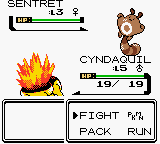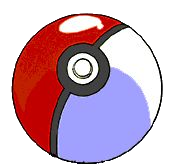- Note: For competitive battling, see the Competitive battling page.
Battling is a major part in Pokémon GS. Approximately 70% of your game time will be spent on battling wild Pokémon or different trainers.
The Basics
- Whenever a trainer spots you, he/she will challenge you to a battle.
- If a trainer does not spot you but you still want to battle, talk to them.
- When you are inside the tall grass, there is a chance that a wild Pokémon will attack you.
- When you are inside of a cave, a wild Pokémon may attack (even without grassy patches).
- Each Pokémon have a maximum of four moves, and a minimum of one move. No Pokémon will have zero or more than four.
- Gym Leaders will not challenge you on their own, you must talk to them to challenge them.
Now that that's covered, let's start the battle.
Wild Pokémon Battle
Whenever a battle starts, you will see the screen flashes and a small animation will occur over the screen.

This is a typical battle against a wild Sentret. In this screen, you can see the sprite of the Pokémon you're fighting, how many Pokémon you have (left), and the name of the Pokémon who appeared.

The main battle screen offers a bit more functions. Let's review them.
Fight
This is the main function at battling. It tells your Pokémon to use a Move. There are 3 general types of moves.
- Damaging Moves - These moves are intended purely to damage your opponent Pokémon. While there might be side effects from an attack, such a status changes or stat changes, damaging is the main idea here.
- Stat Modifying Moves - These moves are there to increase your stats. Or alternatively, make your opponent's stats decrease. Moves like Growl, Tail Wipe or Smokescreen will lower your opponent's stat by one level, while moves like Screech will make them go down by two levels.
- Status Problem Causing Moves - These moves are made to make your opponent do one of the following things:
- Sleep - The victim takes a nap. Making it an easier target for attacks without fearing from counterattack. Also increases the chance to catch a wild Pokémon.
- Paralyze - Will cause the victim's speed to drop by half, in addition, in each turn there is a 25% chance that the victim will not attack at all. A paralyzed wild Pokémon is easier to catch.
- Poison - A poisoned Pokémon will take <1/16 of his total HP> damage every turn. Plus, if the Pokémon is yours, it will take 1 HP damage every 4-5 steps. So it should be treated swiftly.
- Burn - Burn functions like poison in battle, only it also lowers the attack stat of the burned Pokémon, and does not damage outside of battle.
- Freeze - Freezing is a very rare status problem. Due to this fact, it is also the best to cause your opponent. Freeze causes the victim to be completely immobilized, like sleep. it rises the chance to catch a wild Pokémon more than Sleep causes. If your Pokémon is frozen, use a Fire-Type move and it will unfreeze instantly.
- Confusion - Although not really a status problem, confusion is one of the most annoying problems a Trainer will have to go through with an affect Pokémon. The foe will either use a stat or a damaging move that causes confusion. A confused Pokémon may not only NOT attack a foe, but at the same time inflict damage on itself. Confusion can be gone in 2-5 turns or it can be quickly remedied by switching for another Pokémon or given a stat healer like BitterBerry or Full Heal. Confusion always ends when the battle is over and it never sticks with the once-afflicted Pokémon.
- A Pokémon who is affected by a Status Problem can be cured in 2 ways.
- Going to the Pokémon Center will cure all status problems, plus healing your HP and PP to full. If there's a Pokémon Center nearby, go and heal your Pokémon. It's FREE!
- There are items who cure status problems. they will be listed on the Item section.
PKMN
This function serves one purpose: to switch Pokémon in the middle of battle. Of course you can also view summary etc. You cannot use HM moves of other Pokémon in battle, or Teleport or any other moves which have an effect outside of battle.
Pack (Items)
This function is used to use items while in battle. Not all items may be used inside a battle. (For example, Rare Candy or Bicycle may not be used, while Berries and Status Healers may be used) Below is a list of items usable in battle.
Run
This functions works only with Wild Pokémon. When pressing this, you will make an attempt to run. How successful attempt? That varies with your Speed stat, the wild Pokémon Speed stat, and the level difference. If it works, you will run away and continue as if you have won the battle. If you fail to run, it will waste your turn.
Trainer Battle
A Trainer battle is very similar to a wild Pokémon battle. The only difference is that you may not run away, and you might fight multiple Pokémon in a row. If you have enabled it in the Options, you will be asked if you want to replace Pokémon before fighting the next Pokémon.
Another difference is that all Poké Balls are 0% effective. Even the Master Ball. DO NOT TRY IT OR YOUR BALL WILL BE LOST, which is a real shame in the case of the Master Ball, which is unique per game. By all other means, a Trainer battle and a wild Pokémon battle are exactly the same.
Also, after a Trainer battle ends, you will receive or lose money based on the result (you receive money if you win, and lose money if you lose).
